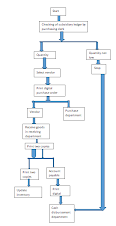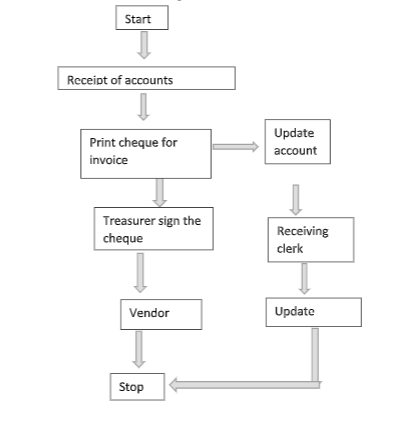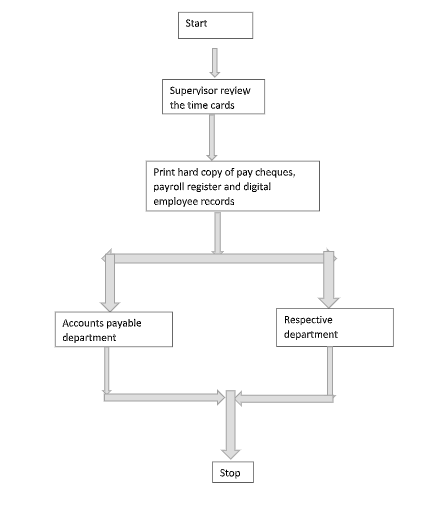Executive summary
In this assignment, the report has been prepared according to the case study of Adam and co. In this report the main focus is on the expenditure cycle to evaluate the processes, risk and internal control in the expenditure cycle. The expenditure cycle includes the purchase system, cash disbursement system and the payroll system. The assignment also includes the flowchart for each and every process of expenditure cycle. The flowcharts that have been prepared in this report are system flowchart of purchase system, system flowchart of cash disbursement system, system flowchart of payroll system. The internal control weakness of each system has been identified and it also includes the risk that the company may face because of such weakness in the internal control system. Therefore, it can be said that the report includes detail about the expenditure cycle of the company and weakness in the internal control procedure that can hinder the work in the future course of action.
Introduction
In this assignment the case study of Adam & co. is given and analysis of the expenditure cycle of the company has been made so that the internal control system of the company can be studied. The case study is of the industrial supplier. The company purchases its inventory from manufacturers in China and Thailand. The company has a centralized accounting system. The expenditure cycle of the company includes purchase system, cash disbursement system and payroll system. The expenditure cycle is a set of actions taken for purchasing the goods in the company. It is the repetitive process of creating the purchase and then ordering the goods. The complete analysis of company’s expenditure cycle has been done so that the internal control weakness, risk, and process can be identified by the managing director so that the necessary actions can be taken to improve the process and system.
1. System flow chart of purchase system

2. System flow chart of cash disbursement system

3. System Flow chart of payroll system

Internal control weakness in each system and risk associated with the identified weakness
The internal control weakness in each system and the risk associated with each system are:
Purchase system
In the purchase system the weakness that can be seen in the internal control procedure of the company is that it does not appear that the current inventories held with the company are checked before placing the orders (Skaife et. al., 2013). It is not clear in the system what procedure is followed by the clerk to selectthe vendor and ordering the goods. The clerk should obtain quotes from vendors in terms of price, delivery date, and quality. These quotes should be then checked by the senior official and then the order should be placed. The entries of the clerk are not cross-checked which may result in the errors that may be deliberate or otherwise may get unnoticed by clerk. The risk that may result because of this weakness isnon-prior checking of the inventories may result in creating a pool of inventories that may not be required by the company (Cheng et. al., 2013). The entries are not checked again which may result in the wrong calculation of the net profit of company.
Cash disbursement system
In the cash disbursement system, the weakness that can be seen in the internal control system is that there is no segregation of duty all the financial transactions are been handled by on person that is the cash disbursement clerk. No proper system of processing of disbursement has been defined in the system. these all the weakness in the internal control system may result in huge loss to the company because cash is the most important element for every organization (Mohamud, 2013). The risk associated with this weakness is that non-segregation of duty may result in balancing the cash at the end of the accounting period.
Payroll system
In the payroll system, the risk that can be identified is that there is no proper employee handbook that clearly states the proper procedure for clocking in and clocking out and problems that may occur because of the wrong entry of the payroll information. The risk that is associated with this is that confusion may be created for the employee’s records (Vona, 2012).
Conclusion
Through this report, it can be concluded that expenditure process of the company includes various internal control weaknesses. This needs to be looked by the managing director so that the work is done smoothly and without errors. The internal control weakness in the expenditure system may result in occurrence of the various risk. The risk that may result because of this weakness is thatnon-prior checking of the inventories may result in creating a pool of inventories that may not be required by the company. The assignment also includes the flowchart for each and every process of expenditure cycle. The flowcharts that have been prepared in this report are system flowchart of purchase system, system flowchart of cash disbursement system, system flowchart of payroll system. Therefore, it can be said that complete details of the expenditure process of Adam & co. Has been analyzed in this assignment.
References
- Alvarez, D.R. and Shapiro, M.A., Nexxo Financial Corp, 2012. Systems and methods for money sharing. U.S. Patent 8,204,829.
- Blowers, A.J., 2013. Method for providing a web-based payroll and payroll related software as a service. U.S. Patent 8,494,927.
- Cheng, M., Dhaliwal, D. and Zhang, Y., 2013. Does investment efficiency improve after the disclosure of material weaknesses in internal control over financial reporting? Journal of Accounting and Economics, 56(1), pp.1-18.
- Grendel, A. and Welter, M., SAP SE, 2013. Method for allocation of budget to order periods and delivery periods in a purchase order system. U.S. Patent 8,423,428.
- Mahajan, K., Shukla, S. and Soni, N., 2015. A Review of Computerized Payroll System. University of Lingaya, Department of Computer Science.
- Maravas, A. and Pantouvakis, J.P., 2012. Project cash flow analysis in the presence of uncertainty in activity duration and cost. International journal of project management, 30(3), pp.374-384.
- Mohamud, H.A., 2013. Internal auditing practices and internal control system in Somali Remittance Firms. International journal of business and Social science, 4(4).
- Schmitt, B., SAP SE, 2014. Managing consistent interfaces for business objects across heterogeneous systems. U.S. Patent 8,799,115.
- Skaife, H.A., Veenman, D. and Wangerin, D., 2013. Internal control over financial reporting and managerial rent extraction: Evidence from the profitability of insider trading. Journal of Accounting and Economics, 55(1), pp.91-110.
- Vona, L.W., 2012. Fraud risk assessment: building a fraud audit program. John Wiley & Sons.